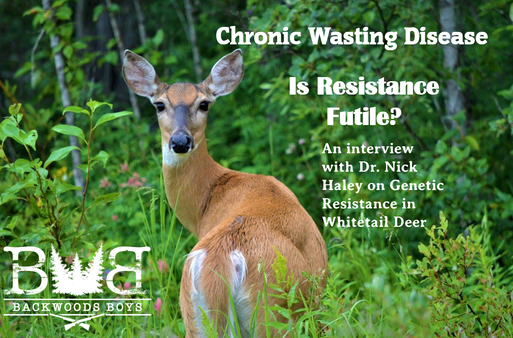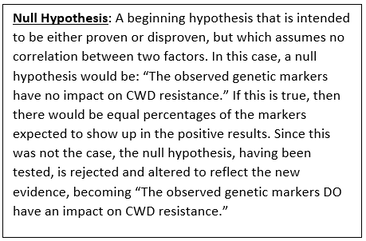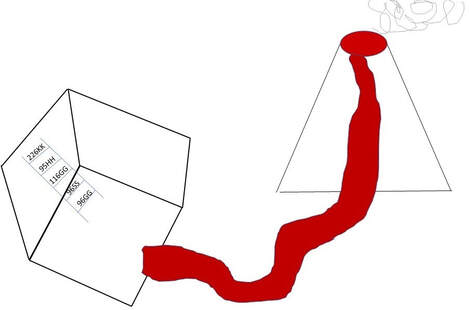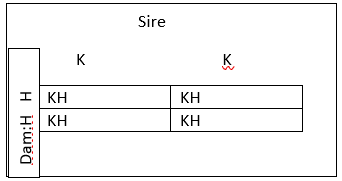

I realize this seems like an odd quote to begin with, but it is a phrase that has been rolling around in my mind for the last while. Once stored in some dusty, near-forgotten corner of my mind, it was dredged up during one of my frequent visits to a popular Facebook group, where the topic of CWD is regularly discussed. Most recently, the CWD discussions have revolved around the exciting realm of “CWD resistance,” where deer breeders have begun to advertise deer as genetically resistant to the CWD prion. No longer are ads comprised simply of impressively antlered bucks with a score attached and perhaps a pedigree—many now include phrases such as “carrier of double alleles for CWD resistance”. Posts advertising sires as carriers of the highly sought-after 226K gene have become more and more common, with the resulting comment threads generally containing a great number of questions regarding the validity of any claim of resistance, as well as wondering about the science behind this new aspect of the deer-breeding market. Consequently, I have spent the past several months mulling over the potential that genetic resistance may hold for deer farming (and even wild deer herds). Is resistance really as good as it sounds? I wondered, or is resistance futile, simply one more grasp at straws to combat the ever-growing threat of CWD?
A quick search of the most recent literature failed to turn up many results about this topic, so I was left pondering my question for a few days. Eventually, I decided to do what any curious soul would do; contact the lead researcher directly and ask him for a crash-course in CWD genetic resistance.
Dr. Nicholas Haley is very open and friendly, and responded to my request for an interview “sometime in the future” with “Sure! How about tomorrow?” Less than 24 hours after approaching him, I was receiving the crash-course to end all crash-courses and by the end of the phone call (which went significantly over my allowed minutes of Canada-US calling on my cellphone plan) I had a good grasp on the science behind the hunt for resistant genes.
The Markers
There are actually five different variations of markers in the whitetail’s genome which can affect an individual’s susceptibility to the CWD prion. These markers began to become of interest during Dr. Haley’s large-scale studies regarding the efficiency of live-tests, where it was observed that several markers were under-represented in the positive results (in other words, they comprised a lesser percentage of the CWD positive animals than would have been statistically expected based on a null hypothesis that the markers do not influence resistance). In most cases, these animals that had the more-resistant markers, even when positive, were only in the early stages of the disease. Clearly this warranted further investigation.
 My truly artistic rendering of the Ladder Example
My truly artistic rendering of the Ladder Example Dr. Haley, however, is quick to refute this claim, basing his argument on observations of the alleles’ geographical distribution. He notes that, as far as he has seen so far, Canadian populations do not have the 226K allele within their genepool. This allele is generally concentrated in the New England area. Conversely, the 116G allele is absent in United States, but present in Canada. The 96S allele, however, is most common in the southern states. To him, this uneven distribution indicates that the various alleles are relatively recent mutations in the genepool, and simply have not had time to be dispersed throughout the population as a whole. Given time, he suspects that these alleles would become more common as interbreeding occurs between populations and as individuals emigrate from one geographical area (and its local populations), immigrating into new areas and populations where their novel genes would be introduced. His argument is further supported by the fact that some animals who are homozygous for the resistant markers, when compared to their twins who are homozygous for the susceptible markers, are identical and unable to be told apart. This indicates that there is no phenotypic (phenotypic: physical expression of a gene) difference resulting from the markers that would influence fitness. He states however, that this is certainly something that will be monitored as time goes on.
The Resistance
It has been stated by many that genetic resistance in deer is the safest bet, because genetic resistance to scrapie was successfully integrated into sheep herds years ago. Consequently, sheep from these resistant lines can no longer contract scrapie. Or so it is commonly believed. Dr. Haley points out, however, that the average lifespan of a sheep is 8-10 years, and so what may appear as bulletproof resistance may actually be a delay in scrapie infection, such that the sheep do not generally live long enough to contract it. It is certainly possible, he says, that given a lifespan of 20 years, these so-called “resistant” sheep may eventually come down with the disease. Thus, the scrapie resistance that has been implemented into sheep populations may be more of a “functional resistance” in that for most practical purposes, the animals are resistant. Given the longer lifespan of farmed deer, however (especially does and breeder bucks), it is possible that the same issue could arise even among the most resistant lines. On the other hand, as the average wild deer only lives to 3 or 4, resistant lines (such as a homozygous 226KK) are much more likely to maintain resistance throughout their lives.
All this talk about markers and resistance had me wondering how they all compare to each other, so I asked Dr. Haley for clarification on this point. He says that the best illustration he has come up with so far is to imagine a ladder in a room that is slowly filling with lava. Each rung on the ladder is a different allele, and the lava is the CWD prion. As the room fills with lava and it reaches each rung, the animals with that allele will come down with CWD. The rung lowest on the ladder (ie. the allele with the least resistance and highest susceptibility) is 96GG, followed by 96SS, 116GG, 95HH, and finally, 226KK. As CWD prevalence grows and prions accumulate in the environment (ie. the lava rises), individuals with each of these markers will contract CWD in turn. The first to go will be those with the 96GG allele, and the last to get it will be those with the 226KK allele. It is important to note, however, that even those with the highest resistance will likely contract CWD if the lava rises too high. As a result, Dr. Haley warns that using terminology such as “immune to CWD” is misleading and may lead to misconceptions and unrealistic expectations. As of this moment, he states, there is no evidence that any allele will make a deer immune to CWD. Rather, the alleles that confer the highest resistance will prevent the individual from contracting it as quickly as the others, potentially allowing the animal to die before contracting the disease. Consequently, it is important that the term “resistant” be used in place of “immune” and that people recognize that “resistant” does not mean 100% resistant—simply more resistant than other markers. Think of it like “water resistant” boots versus “waterproof” boots. If you jump in a puddle with water resistant boots, you are still going to get wet feet (albeit not as rapidly as jumping in with sandals). “Waterproof boots” however will keep your feet dry. As of today, there is no such thing as “CWD-proof” genetics, only “CWD resistant”. Applying this to the speculation that testing a deer and finding that it has the K allele should be as good as a live-test for guaranteeing that the animal does not have CWD, Dr. Haley says that this is not the case. Since the K allele does not guarantee immunity, but rather the highest known level of resistance, finding the K marker in an individual’s genotype would not be comparable to finding it negative (either through a reliable live test or post-mortem test).
Another important consideration when planning a breeding strategy is to remember that these resistant alleles only naturally make up 3-5% of the population. As a result, there is potential for creating a genetic bottleneck, where the majority of future deer can be traced back to the same few sires. Such a situation would greatly decrease the genetic diversity of the domesticated deer population as a whole. If we think it’s difficult to find a unique lines now to avoid inbreeding, then we need to be cautious and far-sighted when creating breeding strategies for resistance as well. Consequently, it is imperative to keep the genepool as broad as possible by identifying as many of these sires as we can, and not breeding everything to the first few sires to show these alleles.

Now all this talk of genes and alleles has had me wondering how a breeding program could make use of this strategy, and what sort of crosses would be most useful. Since each parent donates a single allele for the gene, it is very important to know which alleles each parent has the potential to supply to their offspring. Although much of the fine-tuning of the genetics is not 100% proven, it is believed that the genetics follows traditional Mendelian genetics, meaning if the parental alleles are known, the potential outcomes of these crosses can be fairly easily determined assuming 50/50 chance of either allele being passed down from the parent to the offspring. If, for example, the sire is known to be homozygous KK, he can only provide a K to the offspring. Similarly, if the mother is homozygous HH, she can only provide an H to the offspring. Testing this with a simple Punnett square (although it is simple enough that the diagram doesn’t need to be used) shows us that the all offspring will be heterozygous KH. While it is not known for certain how the different alleles interact, it is believed that they have a “codominant” effect (codominance means each allele expresses somewhat; codominant red flowers and white flowers combine to create pink offspring). In this case then, the offspring would be expected to have resistance somewhere between KK and HH. Dr. Haley speculates that the resistance in such a cross might still be high enough that the offspring would likely die before becoming infected (and so be indifferentiable from KK and HH), but admits that little is known for certain and that high prevalence in the herd could potentially lead to infection of these heterozygous animals. Similarly, a cross between a KK and a GG would result in KG offspring—almost certainly reducing the resistance of the animal to somewhere lower than an HH individual. As a result, it would be important for anyone who decides to pursue the route of genetic resistance to maintain a strong stance against breeding even the most attractive “G” genetics into the herd in an effort to maintain maximal resistance. Consequently, the most ideal crosses would be between a sire and dam both homozygous for the K allele (KK), although such animals are likely few and far between.
As mentioned earlier, it is believed that each allele has a 50% likelihood of being passed down, however, like many of the aspects of genetics in this study, this is not known for 100% certain. Dr. Haley admits that there is some slight anecdotal evidence indicating that the 226K gene may be favourable passed down over the 96G, and that the 95H might be unfavourably passed down compared to the 96G, however, insists that this is likely due simply to a small sample size. It is not, he states, statistically significant at all at this point in time, and is expected to be proven to be 50/50 passdown in the future with a larger sample size.
Vaccines Vs. Resistance
At the moment, the two most popular routes of research are development of resistant lines and development of a vaccine. Each has their pros and their cons, and ironically, the cons for one often are the same for the other. Although some argue that resistance is futile because the deer can still potentially contract CWD and shed the prion, the same applies for any potential vaccine. A flu vaccine, for example, does not guarantee that you won’t get the flu. It reduces the likelihood of contracting the flue and decreases the severity of the sickness. So, arguing that one is better than the other based on the animals shedding prions is a double edged-sword.
Similarly, any argument that the prion could mutate and overcome the resistance runs into the same problem. Dr. Haley states that it would be foolish to ignore the potential for the prion to mutate, however, he points out that the same could easily happen with a vaccine. In fact, one of the reasons why flu vaccines may not be as effective year to year is due to the virus evolving to combat the vaccine.
And while some will insist that developing resistant lines in the wild will take too long unless the higher-ups in Wildlife allow the introduction of resistant lines into the wild (which we all know is never going to happen), Dr. Haley questions whether attempting to vaccinate every deer in the countryside for 50 or so years (until the prions that have accumulated in the soil have a chance to degrade) is really that much more realistic.
In the Wild
Now, you might be thinking “resistance is all well and good on a farm, but how is this going to help with wild populations?” And that’s a great question. Dr. Haley believes nature will eventually select for the resistant lines on its own. While this may sound like good news to us, however, this would likely involve significant declines in the wild population along the way, until the 3-5% of resistant deer become the more prevalent gene-donors. Such a process could take as long as 150-200 years he speculates. Clearly, this would be a long term strategy, best paired with other, more immediately effective short-term management strategies. The existence of resistant genes does not negate the responsibility of deer hunters, farmers, and government to seek out management strategies to mitigate the impacts of CWD along the way.
One Other Potential Strategy
One new line of research that Dr. Haley is exploring, while promising, is also likely to be the most controversial. He is currently working on creating a genome in which the gene susceptible to the prion is completely “knocked out.” In simple terms, a biological “tool” called CRISPR is used to cut the DNA strand on either side of the gene responsible for creating the proteins (that when misfolded become the prion), completely removing it from the genome of the animal. If this process were completed in both a potential sire and mother, the resulting crosses would not be able to pass the susceptible gene on (because they would no longer have the gene themselves to contribute to the cross). While this is an exciting use of cutting-edge biotech (pun intended), it opens a whole slough of issues regarding the morality of creating genetically modified deer (beyond simple selective breeding).
I suspect many deer farmers have heard the accusations leveled at us whenever a member of the public happens across a video of a farmed behemoth on Facebook, when we are subsequently called out (wrongly) for using steroids or “genetically modifying” our deer. Despite the fact that these accusations are unfounded and based on a total misunderstanding of deer farming and genetics, should this route be employed in the battle against CWD, we would no longer be able to truthfully say “nope; it’s all in the breeding.” The truth would be that, while the antlers that are being attributed to genetic modification are still only attained through careful breeding, the animal itself would be a genetically modified animal. And that is a can of worms that Dr. Haley and myself agree we need to be careful about opening. At the moment, a line of cells has been developed with the knocked-out gene, and the next step would be to grow these cells in a petri dish in the lab, followed by development and birth of a fully CWD resistant deer. Obviously, Wildlife would never allow such “monstrosities” to be released into the wild to combat CWD, however, it may be worth considering the fact that, should deer farmers make the jump to these GMO deer somewhere in the future, they could safely and truthfully insist that deer farmers no longer play any role whatsoever in transmitting CWD. Not only would our deer not get sick with CWD, they could not even get it in the first place. Again though, we are forced to debate the morality of genetically modifying animals or potentially contributing to the spread of CWD. Luckily, such a decision is a few years off at the nearest, so we have some time to consider, discuss, and fight over whether such a risk is worth taking.
Finally, with enough new information rattling around in my head that I figured it was time for me to start writing it down before it got lost in whatever corner that Star Trek quote came from, I bid Dr. Haley farewell (and promptly sent him an email full of questions regarding the genetic relationship of the alleles that I had forgotten to ask). Once again, he was quick to offer his insight to these questions, while admitting that nothing is known for certain. How refreshing to hear someone able to both boast about the successes of his research and admit when knowledge is lacking as well as the potential limitations of the research!
No one knows what the future holds for CWD, deer hunting, and deer farming. All we know is that the battle is still raging on and shows no sign of coming to an end any time soon. As a result, it is important that farmers and hunters alike be proactive in both preventing the disease and supporting research that seeks to combat it. Remember that we are all in this together, and we all (deer hunters, deer farmers, wildlife conservationists, and the general public) stand to benefit from any science that may help us overcome this disease. And remember that science works by exploring many routes simultaneously. So every time you see research that seems to conflict (resistance, vaccine, GMO), keep in mind that we are all searching for an answer, and multiple tactics simply increase the likelihood of finding it quickly. Don’t view opposing research as competing, but rather each pushing onward toward a common goal—the eradication of CWD and the growth and continuation of the North American deer hunting tradition.

 RSS Feed
RSS Feed